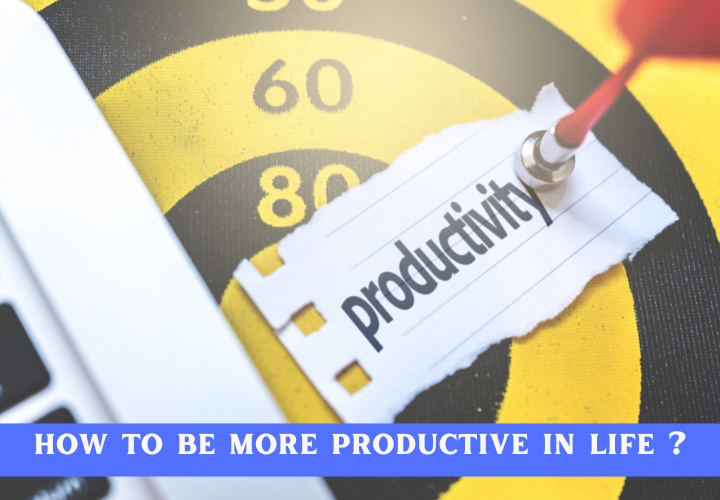This article is about how to be more Productive in life ? Productivity is not just about how much you get done, it's also about how you feel.
There are two types of productivity: organizational and operational. Operational productivity is all about the tasks you complete, while organizational productivity is more focused on how you manage your time and energy.
People who are more productive have the ability to work on a task for longer periods of time before they get distracted or need a break. They also have fewer interruptions from others and distractions from their environment, which allows them to be more productive in general.
Productivity is the measure of efficiency in any given task. It is the ratio of work done to time taken.
Productivity should not be measured by how many hours a person can spend at work but by how much they can accomplish in a given period of time.
It is very important to maintain a good work ethic and healthy life balance because it will help you stay productive and motivated throughout your day-to-day tasks.
Let's take a look as to how you can increase your productivity and get things done.
Be a Better Organizer of Your Time & Tasks
What is the best way to organize your time and tasks? We have created a list of some of the most popular organizing systems that you can use to make your life easier.
There are many different ways to organize your time and tasks. Some people prefer to use a simple list, while others prefer more complicated systems like GTD or Bullet Journaling. Here are five popular ways to organize your day:
– Simple List: This is when you write down all of your tasks in one long list
– Kanban Board: Kanban boards are a visual way of managing work and are often used by teams
– GTD: GTD is an acronym for “Getting Things Done” and was created by David Allen
– Bullet Journaling: Bullet journaling is a system that uses journals, planners, calendars, and other tools to keep track of time management
– Task Manager Apps: These apps allow users to create lists, set due dates, assign priorities, and track time.
Get Back to the Basics of Doing More in Less Time
Let me share with you some wonder tips for getting done more in less time. Here are my 6 tips for you on this subject of getting things done.
1) Start with the end in mind :
Start with the end in mind is a productivity technique that helps you create a plan for your work. It is an easy way to stay on track and get things done.
The technique helps you set goals and identify specific, measurable actions to take to reach them. This will give you a sense of accomplishment when you finish each step, which will motivate you to keep going until the desired outcome is achieved.
Start with the end in mind can be applied to many aspects of life, including work, relationships and personal projects. The idea is simple: if we want something we need to know where we are going and what steps are required to get there in order for it not be like a blind man walking through life without direction or purpose.
2) Set clear goals :
When you know what you want to accomplish, the task becomes much more manageable. You can break it down into smaller steps and come up with a plan of action.
The first step in setting clear goals is to identify the things that are important to you, then prioritize them. Once you have your list, start thinking about how much time/energy/resources it will take to complete each goal. This will help you set realistic expectations for yourself and figure out what goals are most important for your current situation.
The next step is to create a timeline for each goal and mark it with your deadlines. This will help you stay on track and give yourself something concrete to work towards instead of just floating around aimlessly without any direction or focus.
3) Divide and conquer :
Dividing and conquering is a technique that can be applied to any task. It can be used to break down large projects into smaller, more manageable tasks.
This technique is very useful in the workplace because it helps employees stay on top of their work and complete tasks quickly.
The concept of dividing and conquering is simple: when faced with a large task, break the task into smaller, more manageable parts. This will reduce the risk of feeling overwhelmed by the project and give you a sense of accomplishment when each part is completed.
4) Prioritize your tasks
The key is to make a list of all the tasks that need to be done and rank them in order of priority. What is the most important thing that needs to be done? What is the second most important thing? Etc. Once you have ranked them, start with the task at the top of your list. .This is a great strategy because it will allow you to focus your time on the tasks that have the biggest impact, rather than spending all your time in meetings and other unimportant tasks.
5) Use time-blocking to limit distractions
Time blocking is a productivity technique that can help you stay focused and get more done. It is a time management strategy where you divide your day into blocks of time for specific tasks and activities.
It can be helpful to have an understanding of the different types of time blocks. There are three types: task-based, goal-based, and habit-based. Task-based blocks are for specific tasks that need to be completed in a certain amount of time. Goal-based blocks are used when you want to accomplish something by a certain date or deadline. Habit-based blocks are used when you want to do something on a regular basis, such as exercise or meditation.
6) Take regular breaks
The key to increased productivity is not to work continuously for hours on end, but instead, to take regular breaks.
In his book “The 4-Hour Workweek,” author Tim Ferriss recommends the following:
“Take a 10-minute break for every 60 minutes of work.”
This means that if you're working for 8 hours a day, you'll take 16 10-minute breaks.
This will allow you to eat healthy meals and have time to relax without feeling pressured.
It also helps prevent burnout and mental fatigue.
In order to be productive, you need to know and understand your strengths.
Find out what you are good at, and what you are not so good at.
Once you figure this out, it will be easier for you to make decisions on where to spend your time and energy.
You need to know the best way for your brain to work in order for it to be productive.
Give yourself enough time and space in order for your brain can do its best work.
Implement the above tips on productivity in your daily life and see your productivity soar.


